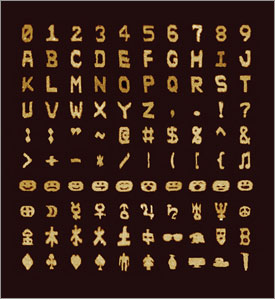Novel technology could enable new tools for delivering drugs directly to disease sites in the body
Researchers at the Wyss Institute have developed a method for building complex nanostructures out of short synthetic strands of DNA. Called single-stranded tiles (SSTs), these interlocking DNA “building blocks,” akin to Legos®, can be programmed to assemble themselves into precisely designed shapes, such as letters and emoticons. Further development of the technology could enable the creation of new nanoscale devices, such as those that deliver drugs directly to disease sites.
The technology, which is described in today’s online issue of Nature, was developed by a research team led by Wyss core faculty member Peng Yin, Ph.D., who is also an Assistant Professor of Systems Biology at Harvard Medical School. Other team members included Wyss Postdoctoral Fellow Bryan Wei, Ph.D., and graduate student Mingjie Dai.
DNA is best known as a keeper of genetic information. But in an emerging field of science known as DNA nanotechnology, it is being explored for use as a material with which to build tiny, programmable structures for diverse applications. To date, most research has focused on the use of a single long biological strand of DNA, which acts as a backbone along which smaller strands bind to its many different segments, to create shapes. This method, called DNA origami, is also being pursued at the Wyss Institute under the leadership of Core Faculty member William Shih, Ph.D. Shih is also an Associate Professor in the Department of Biological Chemistry and Molecular Pharmacology at Harvard Medical School and the Department of Cancer Biology at the Dana-Farber Cancer Institute.

In focusing on the use of short strands of synthetic DNA and avoiding the long scaffold strand, Yin’s team developed an alternative building method. Each SST is a single, short strand of DNA. One tile will interlock with another tile, if it has a complementary sequence of DNA. If there are no complementary matches, the blocks do not connect. In this way, a collection of tiles can assemble itself into specific, predetermined shapes through a series of interlocking local connections.
In demonstrating the method, the researchers created just over one hundred different designs, including Chinese characters, numbers, and fonts, using hundreds of tiles for a single structure of 100 nanometers (billionths of a meter) in size. The approach is simple, robust, and versatile.
As synthetically based materials, the SSTs could have some important applications in medicine. SSTs could organize themselves into drug-delivery machines that maintain their structural integrity until they reach specific cell targets, and because they are synthetic, can be made highly biocompatible.
“Use of DNA nanotechnology to create programmable nanodevices is an important focus at the Wyss Institute, because we believe so strongly in its potential to produce a paradigm-shifting approach to development of new diagnostics and therapeutics,” said Wyss Founding Director, Donald Ingber, M.D., Ph.D.
The research was supported by the Office of Naval Research, the National Science Foundation, the National Institutes of Health, and the Wyss Institute at Harvard University.
